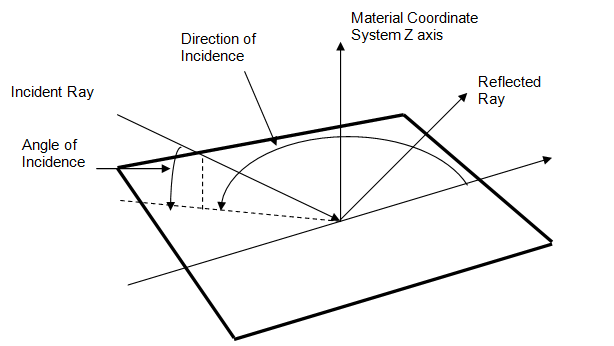Angle dependent surface properties
This section explains how specular reflectivity or transmissivity is determined for elements based on the angle of incidence.
For some elements, specular reflectivity or transmissivity may be defined as a function of the angle of incidence. For these elements, the specular reflectivity or transmissivity is determined by linear interpolation of the data in the array referenced by the material property. If the incident angle falls outside the range defined in the array, the thermal solver uses the value at the nearest limit and does not extrapolate.

The direction of incidence is determined by projecting the ray onto the plane defined by the element surface normal and then determining the angle between this projection and the material orientation vector for the element. The angle of incidence is the angle between the incoming ray and the surface normal.
- For specular elements j, the new direction is calculated by assuming the angle of incidence is equal to the angle of reflection with respect to the local surface normal.
- For transparent elements j, if the indices of refraction on both sides of the element are not specified or are equal, the direction of the transmitted ray is the same as the incident ray. However, if the indices of refraction are specified and are different, then a new direction for the ray's travel is calculated using Snell's Law:
Where:
- θinc is the angle the incident ray makes with the surface normal.
- θtrans is the angle the transmitted ray makes with the surface normal.
- Iinc is the index of refraction on the incident side of the element.
- Itrans is the index of refraction on the transmitted side of the element.
The index of refraction is assumed to be spectrum-independent, and the element j is assumed to have the same indices of refraction in both the IR and solar spectra.
If Iinc > Itrans (i.e., the ray goes from a dense to a less dense material), the computed sin(θtrans) may be > 1. In this case, the material is assumed to reflect specularly, with the specular reflectivity equal to the transmissivity of the material.
If element j is planar, the local surface normal is the same as the surface normal of the element.
